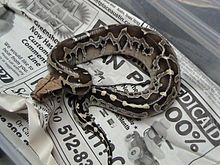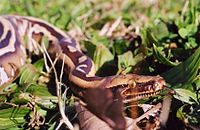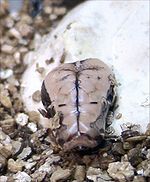- Python curtus breitensteini
-
Python curtus breitensteini 
Scientific classification Kingdom: Animalia Phylum: Chordata Subphylum: Vertebrata Class: Reptilia Order: Squamata Suborder: Serpentes Family: Pythonidae Genus: Python Species: P. curtus Subspecies: P. c. breitensteini Trinomial name Python curtus breitensteini
Steindachner, 1880Synonyms - Python breitensteini - Steindachner, 1880
- Python curtus breitensteini - Stull, 1935
- Python curtus breitensteini - Stimson, 1969[1]
- Common names: Borneo short-tailed python, Borneo python.
Python curtus breitensteini is a non-venomous python subspecies[2] found mostly on the island of Borneo.
Contents
Description
Adults have been reported to attain a length of 2.1 m (7 feet), although they are usually no more than 1.2 m (4 feet). Heavy-bodied, they can weigh as much as 13.6 kg (30 lb). Females are generally larger than males. The head is broad with several thermoreceptive pits along the nose. The tail is short and tapering.
The color pattern is usually tan with brown blotching, which varies greatly. Though there have been no reported instances of albinism, a few individuals display a significantly lighter color, appearing more yellow than brown. Juveniles have a more contrasting pattern than adults. The head is usually yellow.
Geographic range
Found mostly in Indonesia and Malaysia, on the island of Borneo, they also have been recorded in Singapore. Has also been found on Sumatra, Bangka Island and others islands in the Strait of Malacca, including the Lingga Island, the Riau Islands, and Bintan.
The type locality given is "Teweh, Borneo."[1]
Habitat
Typically found at lower elevations, on poorly drained flood plains, or on the edges of swampy areas. Man-made irrigation of farmland has also provided appropriate habitat.
Captivity
While the species as a whole generally has a reputation for being mean-tempered, this subspecies is increasing in popularity among reptile enthusiasts. This is due to captive bred specimens being recognized as easier to handle than wild-caught snakes. Almost all of the early imported animals were animals that were originally caught for the skin trade.
Taxonomy
Elevated to a full species by Keogh, Barker and Shine (2001).[3]
See also
- List of pythonid species and subspecies.
- Pythonidae by common name.
- Pythonidae by taxonomic synonyms.
References
- ^ a b McDiarmid RW, Campbell JA, Touré T. 1999. Snake Species of the World: A Taxonomic and Geographic Reference, vol. 1. Herpetologists' League. 511 pp. ISBN 1-893777-00-6 (series). ISBN 1-893777-01-4 (volume).
- ^ "Python curtus breitensteini". Integrated Taxonomic Information System. http://www.itis.gov/servlet/SingleRpt/SingleRpt?search_topic=TSN&search_value=635073. Retrieved 15 September 2007.
- ^ Python breitensteini at the Reptarium.cz Reptile Database. Accessed 15 September 2007.
Further reading
- Keogh, JS, Barker DG, Shine R. 2001. Heavily Exploited but Poorly Known: Systematics and Biogeography of Commercially Harvested Pythons (Python curtus group) in Southeast Asian. Biological Journal of the Linnean Society 73:113-129
External links
- Bloodpythons.com. Accessed 15 September 2007.
Categories:
Wikimedia Foundation. 2010.


